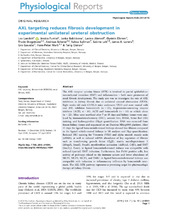| dc.contributor.author | Landolt, Lea Zoe | en_US |
| dc.contributor.author | Furriol, Jessica | en_US |
| dc.contributor.author | Babickova, Janka | en_US |
| dc.contributor.author | Ahmed, Lavina | en_US |
| dc.contributor.author | Eikrem, Øystein Solberg | en_US |
| dc.contributor.author | Skogstrand, Trude | en_US |
| dc.contributor.author | Scherer, Andreas | en_US |
| dc.contributor.author | Suliman, Salwa | en_US |
| dc.contributor.author | Leh, Sabine Maria | en_US |
| dc.contributor.author | Lorens, James | en_US |
| dc.contributor.author | Gausdal, Gro | en_US |
| dc.contributor.author | Marti, Hans-Peter | en_US |
| dc.contributor.author | Osman, Tarig Al-Hadi | en_US |
| dc.date.accessioned | 2020-02-11T14:01:25Z | |
| dc.date.available | 2020-02-11T14:01:25Z | |
| dc.date.issued | 2019 | |
| dc.Published | Landolt LZ, Furriol J, Babickova J, Ahmed L, Eikrem Ø, Skogstrand T, Scherer A, Suliman SMN, Leh S, Lorens J, Gausdal G, Marti HP, Osman T. AXL targeting reduces fibrosis development in experimental unilateral ureteral obstruction. Physiological Reports. 2019;7(10):e14091 | eng |
| dc.identifier.issn | 2051-817X | |
| dc.identifier.uri | https://hdl.handle.net/1956/21392 | |
| dc.description.abstract | The AXL receptor tyrosine kinase (RTK) is involved in partial epithelial-tomesenchymal transition (EMT) and inflammation – both main promoters of renal fibrosis development. The study aim was to investigate the role of AXL inhibition in kidney fibrosis due to unilateral ureteral obstruction (UUO). Eight weeks old male C57BL/6 mice underwent UUO and were treated with oral AXL inhibitor bemcentinib (n = 22), Angiotensin-converting enzyme inhibitor (ACEI, n = 10), ACEI and bemcentinib (n = 10) or vehicle alone (n = 22). Mice were sacrificed after 7 or 15 days and kidney tissues were analyzed by immunohistochemistry (IHC), western blot, ELISA, Sirius Red (SR) staining, and hydroxyproline (Hyp) quantification. RNA was extracted from frozen kidney tissues and sequenced on an Illumina HiSeq4000 platform. After 15 days the ligated bemcentinib-treated kidneys showed less fibrosis compared to the ligated vehicle-treated kidneys in SR analyses and Hyp quantification. Reduced IHC staining for Vimentin (VIM) and alpha smooth muscle actin (aSMA), as well as reduced mRNA abundance of key regulators of fibrosis such as transforming growth factor (Tgfb), matrix metalloproteinase 2 (Mmp2), Smad2, Smad4, myofibroblast activation (Aldh1a2, Crlf1), and EMT (Snai1,2, Twist), in ligated bemcentinib-treated kidneys was compatible with reduced (partial) EMT induction. Furthermore, less F4/80 positive cells, less activity of pathways related to the immune system and lower abundance of MCP1, MCP3, MCP5, and TARC in ligated bemcentinib-treated kidneys was compatible with reduction in inflammatory infiltrates by bemcentinib treatment. The AXL RTK pathway represents a promising target for pharmacologic therapy of kidney fibrosis. | en_US |
| dc.language.iso | eng | eng |
| dc.publisher | Wiley | eng |
| dc.rights | Attribution CC BY | eng |
| dc.rights.uri | http://creativecommons.org/licenses/by/4.0/ | eng |
| dc.title | AXL targeting reduces fibrosis development in experimental unilateral ureteral obstruction | en_US |
| dc.type | Peer reviewed | |
| dc.type | Journal article | |
| dc.date.updated | 2020-02-11T13:55:57Z | |
| dc.description.version | publishedVersion | en_US |
| dc.rights.holder | Copyright 2019 The Authors | |
| dc.identifier.doi | https://doi.org/10.14814/phy2.14091 | |
| dc.identifier.cristin | 1714236 | |

